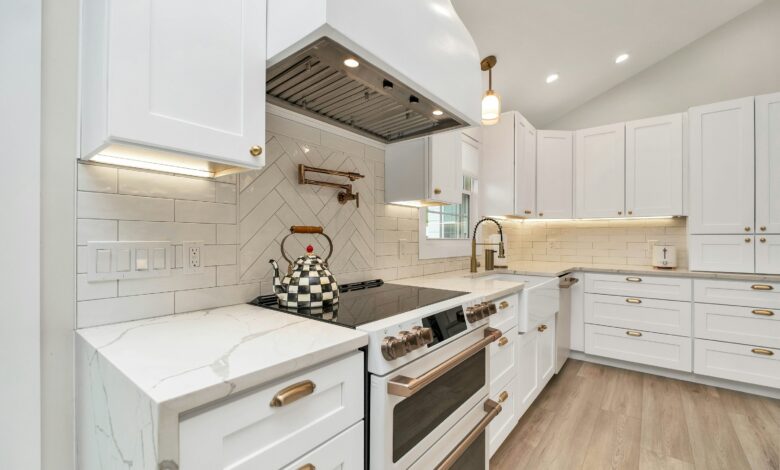Kitchen Remodeling: A Comprehensive Guide to Transforming Your Kitchen into a Functional and Stylish Space

Kitchen remodeling is one of the most impactful home renovation projects. As one of the most frequently used rooms in the house, the kitchen not only serves as a cooking area but also as a gathering place for friends and family. Therefore, a well-designed kitchen can elevate your home’s aesthetic appeal, increase its functionality, and even boost its resale value. In this article, we’ll explore various aspects of kitchen remodeling, from planning and budgeting to design trends and practical tips, to help you create a kitchen that’s both beautiful and efficient.
Why Remodel Your Kitchen? The decision to remodel your kitchen often stems from practical needs as well as a desire for an updated aesthetic. Kitchens wear out over time, with appliances becoming outdated, cabinetry showing signs of wear, and layouts no longer meeting your family’s needs. Remodeling can address these issues by modernizing appliances, increasing storage, creating a better layout, and even introducing eco-friendly materials and energy-efficient technology. Not only will this make daily use easier, but it will also create a space you love spending time in.
Setting a Budget for Your Kitchen Remodel Budgeting is a crucial first step. Kitchen remodels can range widely in cost, from a few thousand dollars for minor updates to upwards of $50,000 for high-end renovations. The key to a successful kitchen remodel is to balance quality and cost by setting a realistic budget. Start by defining the scope of your project. Are you doing a full remodel with new cabinets, floors, and appliances, or are you focusing on specific updates like replacing countertops and adding new fixtures? If you’re looking to increase the home’s value, experts recommend allocating around 10-15% of your home’s overall value to the kitchen remodel. Make sure to reserve at least 10-15% of your budget as a contingency for unexpected expenses. By planning carefully, you’ll ensure that you stay within your financial limits while achieving your desired results.
Choosing the Right Layout for Functionality When designing your kitchen, layout is one of the most important factors. An effective layout maximizes space, improves workflow, and ensures that cooking and entertaining are enjoyable. Common kitchen layouts include the L-shape, U-shape, galley, and open-plan designs. Each layout has its own advantages, so consider your space and cooking habits. For example, U-shaped kitchens are great for maximizing storage and counter space, while open-plan kitchens are ideal for families who enjoy entertaining. The “kitchen work triangle” concept is often helpful, which aims to create an efficient flow between the sink, stove, and refrigerator. However, modern kitchens often adapt this idea to include an island or a fourth zone for prep work, coffee, or baking.
Cabinetry and Storage Solutions Cabinets are a core feature in any kitchen, accounting for both aesthetics and functionality. When selecting cabinets, choose materials that suit your style and budget. Wood remains a popular choice for its durability and versatility, but there are also alternatives like MDF and laminate for those seeking lower-cost options. Opt for cabinetry styles that align with your aesthetic, whether that’s traditional raised-black steel doors, modern flat-fronts, or the classic look of Shaker-style cabinets. In addition to looks, functionality is critical. Integrating storage solutions, such as pull-out shelves, deep drawers, lazy Susans, and vertical dividers, can make a world of difference in keeping your kitchen organized and clutter-free. Custom cabinets are ideal if you have unique storage needs, but they do come at a higher price. Pre-made cabinets are more budget-friendly and still offer excellent quality and a wide range of styles.
Selecting Countertops that Balance Style and Durability Countertops are another focal point of the kitchen and need to withstand frequent use. Today’s options range from natural stones like granite and marble to engineered quartz, butcher block, and laminate. Granite and quartz are popular choices for their durability and array of color options. Marble, while elegant, requires more maintenance due to its susceptibility to staining. Butcher block countertops bring warmth and character to the kitchen, especially in farmhouse or rustic styles, but they also need regular sealing to protect against moisture. Quartz, on the other hand, is a non-porous and highly durable material that requires minimal maintenance. Choosing the right countertop material depends on your cooking habits, aesthetic preferences, and budget. For example, a busy family might prioritize quartz or granite for their durability, while an occasional cook could opt for marble for its luxurious appeal.
Flooring for Both Style and Durability Kitchen floors take a lot of wear and tear, so choosing a durable material is essential. Flooring options include ceramic or porcelain tile, hardwood, laminate, and vinyl. Ceramic and porcelain tiles are popular due to their water resistance and durability, making them ideal for kitchens. Hardwood floors add warmth and a timeless appeal, though they may require refinishing to keep them looking fresh. Laminate and vinyl are budget-friendly options that mimic the look of wood or tile while offering water resistance and easy maintenance. Be sure to consider slip resistance, ease of cleaning, and durability when choosing your flooring, as these factors will impact the floor’s functionality over time.
Lighting that Enhances Both Functionality and Ambiance Good lighting is a key element in kitchen remodeling. It serves both a practical purpose and enhances the kitchen’s ambiance. Aim for layered lighting, which combines ambient, task, and accent lighting. Ambient lighting provides general illumination and can come from overhead fixtures or recessed lights. Task lighting is critical for food prep areas, such as countertops, the stove, and the sink. Under-cabinet lighting is particularly useful, as it illuminates work areas without creating harsh shadows. Accent lighting can highlight architectural features or decor, adding depth and dimension to your kitchen. Don’t underestimate the importance of natural lighting as well; large windows or a strategically placed skylight can brighten up the space and make it feel open and inviting.
Appliance Upgrades for Improved Functionality and Energy Efficiency Kitchen remodeling is an ideal time to upgrade your appliances. Modern appliances not only improve functionality but can also reduce energy costs. When choosing appliances, look for energy-efficient models with the ENERGY STAR label, as these appliances are designed to consume less energy. Stainless steel remains a popular choice for its durability and timeless appeal, but newer finishes like matte black or white are gaining traction. Think about your cooking habits when selecting appliances: if you love to cook, a professional-grade range might be worth the investment, while a compact dishwasher might suffice for a smaller household. High-tech options like smart refrigerators and voice-activated faucets are also becoming more popular, making kitchens more convenient and user-friendly.
Choosing a Backsplash to Add Personality Backsplashes protect walls from spills and splashes while adding a decorative element to the kitchen. Tile backsplashes are common, with subway tiles offering a classic look and mosaic or patterned tiles adding visual interest. For a modern or minimalist kitchen, consider a sleek, slab backsplash made from quartz, marble, or even stainless steel. Beyond tile, you can use materials like glass, mirrored tiles, or even reclaimed wood for a unique touch. The backsplash is a chance to inject personality into your kitchen design and should complement your countertops and cabinetry for a cohesive look.
Adding Personal Touches Through Decor Once the main elements are in place, it’s time to add the finishing touches that reflect your personal style. Small decor items like a stylish pendant light, colorful bar stools, or a charming rug can elevate the kitchen’s aesthetic without overwhelming the space. Plants are an excellent way to bring freshness into the kitchen, and herbs like basil or rosemary can be both decorative and functional. Open shelves or glass-front cabinets provide opportunities to showcase decorative dishware or other unique pieces. Just remember to keep decor minimal to avoid clutter, especially if you use your kitchen heavily.
Hiring Professionals for Quality Workmanship Kitchen remodeling is a complex project that often requires the expertise of professionals. Hiring experienced contractors, designers, and electricians ensures that your remodel is done safely and to a high standard. When choosing contractors, look for professionals with specific experience in kitchen remodeling. Request portfolios of their past work and read reviews from other clients. It’s essential to communicate your goals clearly and be open to feedback, as contractors can offer valuable insights on feasibility and design. Involving professionals in the planning stages can also help you avoid costly mistakes and keep the project on schedule.
Avoiding Common Remodeling Pitfalls While remodeling can be an exciting journey, it’s easy to make mistakes along the way. One common mistake is focusing too heavily on aesthetics at the expense of functionality. For example, a trendy but impractical layout may look beautiful but could frustrate you during daily use. Another pitfall is underestimating storage needs. A cluttered kitchen can quickly become a source of stress, so be sure to incorporate plenty of cabinets, drawers, and organizational solutions. Overlooking the importance of a contingency fund is another frequent issue; unexpected expenses can arise, and having a buffer in your budget will help you handle these surprises without compromising your remodel.
Timelines and Patience Kitchen remodeling requires patience, as projects can take weeks to months to complete depending on their scope. Preparing for this process mentally and logistically, especially if you’ll be living at home during the remodel, is essential. Consider setting up a temporary kitchen to make meal prep easier and anticipate delays that may arise due to material availability or unforeseen issues. Remember, a beautifully finished kitchen is worth the wait.
The Long-Term Impact of Kitchen Remodeling A well-executed kitchen remodel has lasting benefits, from improved daily enjoyment to a potentially higher home resale value. Whether you plan to stay in your home for years or are remodeling to increase market appeal, a functional and stylish kitchen will always be a worthwhile investment. Many homeowners find that a remodeled kitchen inspires them to cook more and entertain more often, creating memories with family and friends in a beautiful setting.
In conclusion, kitchen remodeling offers an opportunity to enhance both the style and functionality of one of the most important rooms in your home. By carefully planning your budget, choosing materials that balance aesthetics and durability, and prioritizing layout and lighting, you can create a kitchen that meets your needs and reflects your personal taste. With the help of professionals and a clear vision, your kitchen remodel can transform your space into a place of comfort, style, and functionality that you’ll love for years to come.
